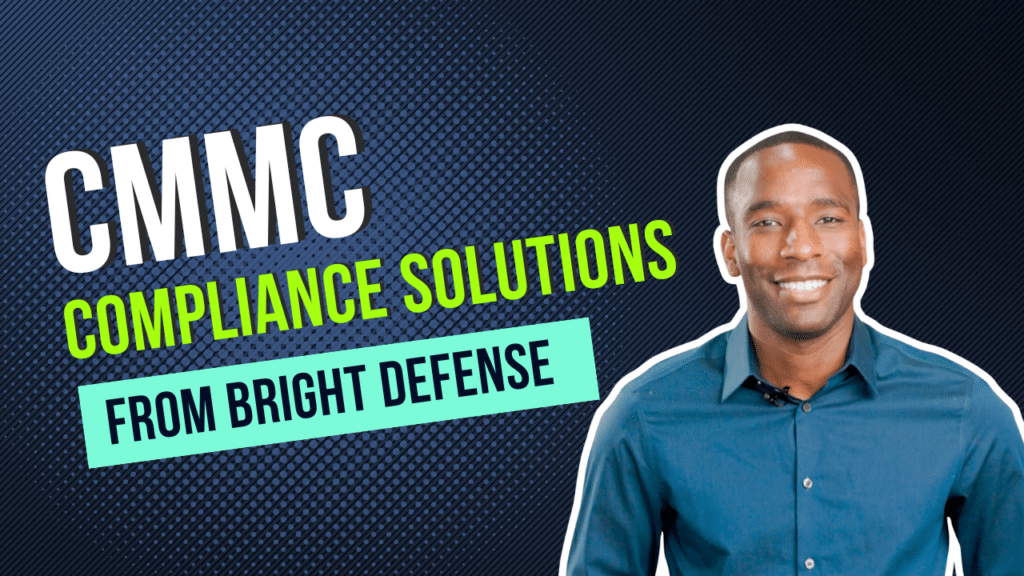
John Minnix
February 16, 2025
StateRAMP vs. FedRAMP: Navigating Local and Federal Cybersecurity Standards
Introduction to StateRAMP vs. FedRAMP
Understanding the nuances between different cybersecurity frameworks is essential in the complex world of government IT contracting. StateRAMP vs. FedRAMP is a common comparison for organizations looking to do business with government agencies. While similar in their aims to safeguard data integrity and security, these frameworks cater to different governmental levels. FedRAMP is for federal, and StateRAMP is for state and local agencies.
Both StateRAMP and FedRAMP are based on the NIST (National Institute of Standards and Technology) Special Publication 800-53. NIST 800-53 provides a catalog of security and privacy controls for federal information systems and organizations. It protects the confidentiality, integrity, and availability of information systems.
FedRAMP specifically uses the NIST SP 800-53 controls as a baseline for its security requirements. It adapts them to the specific needs of cloud services. StateRAMP also follows this model. It applies these controls to ensure that cloud solutions provided to state and local governments meet similar rigorous standards as those required at the federal level. This alignment ensures a consistent approach to security across different government levels, facilitating compliance and interoperability between systems.
Our article aims to demystify these frameworks. We will highlight their similarities and differences, and discuss their implications for small businesses. Let’s get started!

Understanding FedRAMP
The Federal Risk and Authorization Management Program (FedRAMP) standardizes the security assessment, authorization, and continuous monitoring of cloud services across the federal government.
FedRAMP compliance is a mandate for all cloud service providers (CSPs) that wish to work with federal agencies. It ensures that the data these providers handle meets stringent security and privacy protections.
NIST SP 800-53 provides the security controls, tailored for cloud security. Benefits of FedRAMP certification include access to a broad federal market and improved trustworthiness as a secure cloud service provider. However, due to its complexity and cost, the pathway to FedRAMP compliance can be challenging, especially for smaller providers. Businesses must undergo a thorough assessment process, continuously monitor their systems, and obtain regular reauthorizations.
FedRAMP Process Overview
For small businesses, achieving FedRAMP authorization is both a gateway and a barrier to entry into federal contracts. The process involves three main steps:
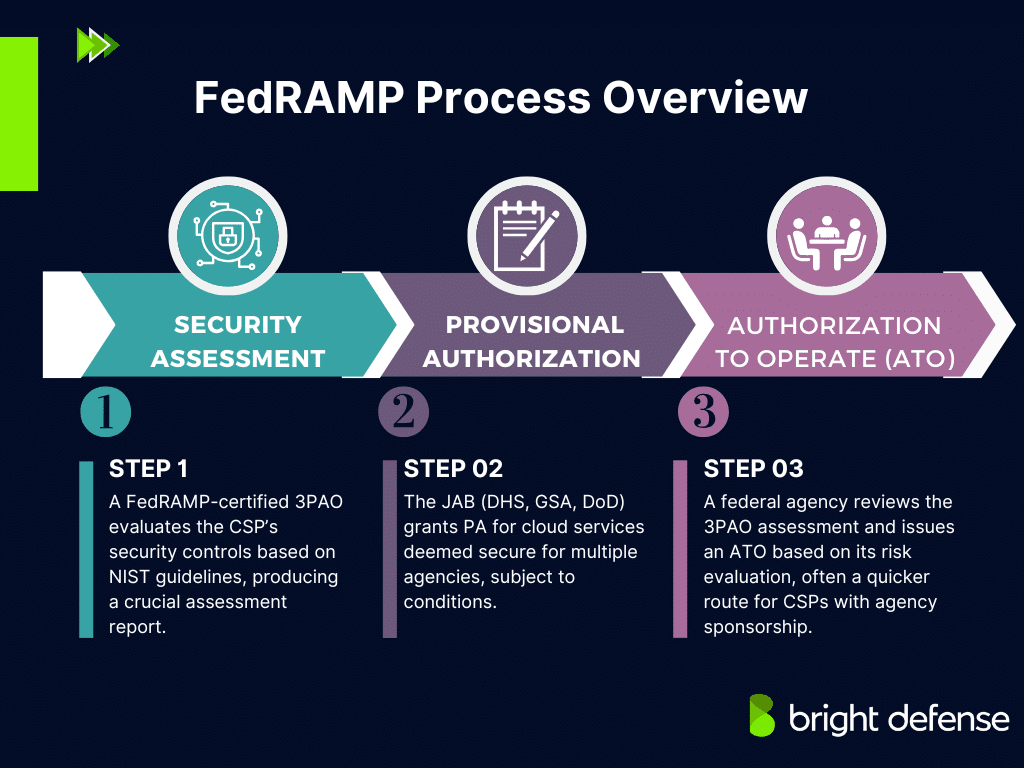
- Initiating a Security Assessment: This step involves selecting a Third Party Assessment Organization (3PAO) certified by FedRAMP. The 3PAO conducts an initial comprehensive assessment of the cloud service provider’s (CSP) systems to ensure they meet the required security controls based on NIST guidelines. The security assessment report is a crucial document outlining the security posture of the CSP’s services.
- Obtaining Provisional Authorization from a Joint Authorization Board (JAB): The JAB consists of representatives from the Departments of Homeland Security (DHS), General Services Administration (GSA), and Defense (DoD). Provisional Authorization (PA) from the JAB means the cloud service has been deemed secure enough for use across federal agencies, subject to specific conditions. CSPs typically pursue This authorization by offering services that have broad applicability across multiple agencies.
- Receiving an Authorization to Operate (ATO) from an Agency: An ATO is issued directly by a federal agency that intends to use the cloud service. The agency reviews the 3PAO assessment and, based on its risk posture, decides whether to authorize the cloud service. Obtaining an ATO can be a faster path for CSPs with a specific agency ready to sponsor their service.
For more detailed guidance on FedRAMP, you can visit the official FedRAMP website.
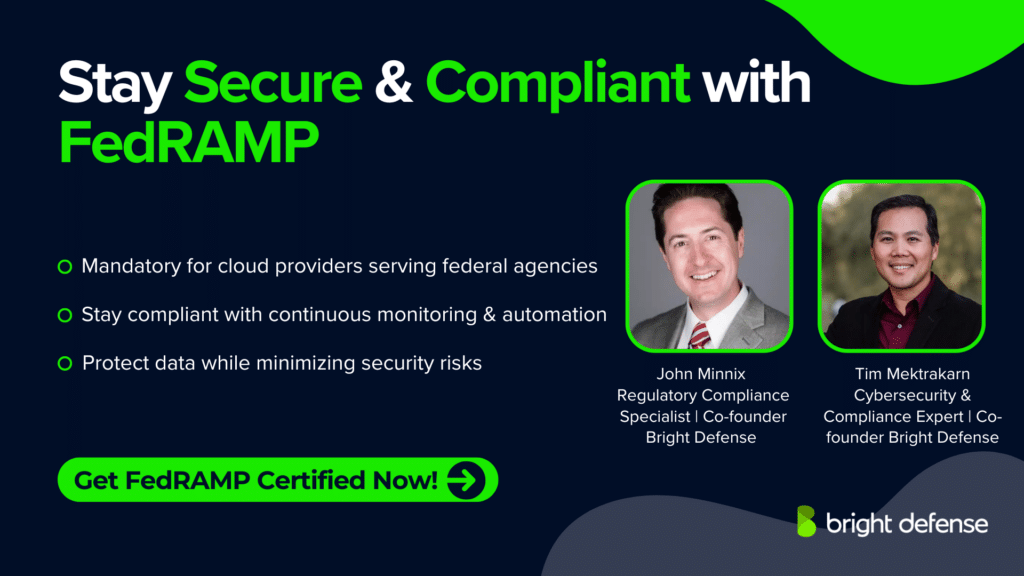
Understanding StateRAMP
StateRAMP was launched as a counterpart to FedRAMP. It aims to provide similar security assurances for cloud services used by state and local governments. StateRAMP leverages FedRAMP standards to create a harmonized approach to cloud security tailored to the needs of state and local governments. Providers who are already FedRAMP authorized can often use their existing security packages to achieve StateRAMP compliance, thereby reducing duplication of effort.
The process for achieving StateRAMP certification mirrors FedRAMP’s but is adapted to smaller governmental bodies’ scale and specific needs. StateRAMP benefits businesses by increasing their marketability to state and local government clients. It also allows them to demonstrate compliance with respected security standards without the need for separate assessments.
StateRAMP is particularly important for businesses that operate primarily at the state or local level. Compliance helps build trust with these government clients and provides a competitive edge in securing contracts. To learn more about how StateRAMP works and how it can benefit your business, visit the official StateRAMP website.
State-Specific Adaptations of StateRAMP
States are developing their own versions of StateRAMP. These adapt the StateRAMP framework to meet their local governments’ requirements. These include:
- AZRAMP (Arizona RAMP): Designed specifically for Arizona, AZRAMP ensures that cloud service providers meet stringent security standards that align with Arizona’s unique legislative and regulatory environment. It emphasizes compliance with local data protection laws and aims to bolster the state’s defenses against emerging cyber threats. Learn more at Arizona’s Department of Administration website.
- GA-RAMP (Georgia RAMP): GA-RAMP extends the principles of StateRAMP to meet the specific needs of Georgia’s state agencies. This program focuses on integrating state-level security policies with nationally recognized standards. It ensures that cloud services used by state agencies are secure and compliant with Georgia’s specific requirements. More information can be found on Georgia’s Technology Authority website.
- OH-RAMP (Ohio RAMP): Tailored to Ohio’s specific regulatory framework, OH-RAMP ensures that all cloud-based services used by state entities adhere to a set of security protocols that protect against state-specific cyber vulnerabilities. Ohio’s adaptation emphasizes collaboration between public and private sectors to enhance state-wide cybersecurity resilience. Details are available at Ohio’s Department of Administrative Services website.
- TX-RAMP (Texas RAMP): TX-RAMP provides a robust framework for Texas, requiring cloud service providers to comply with a comprehensive set of security controls that are specifically designed to address the cybersecurity challenges faced by Texas state agencies. This includes heightened measures for data privacy and security to cater to Texas’s extensive public sector. Further information can be accessed on Texas’s Department of Information Resources website.
These state-specific adaptations of StateRAMP ensure compliance with local regulations. They also significantly improve the security infrastructure of state and local governments by addressing region-specific cybersecurity challenges.
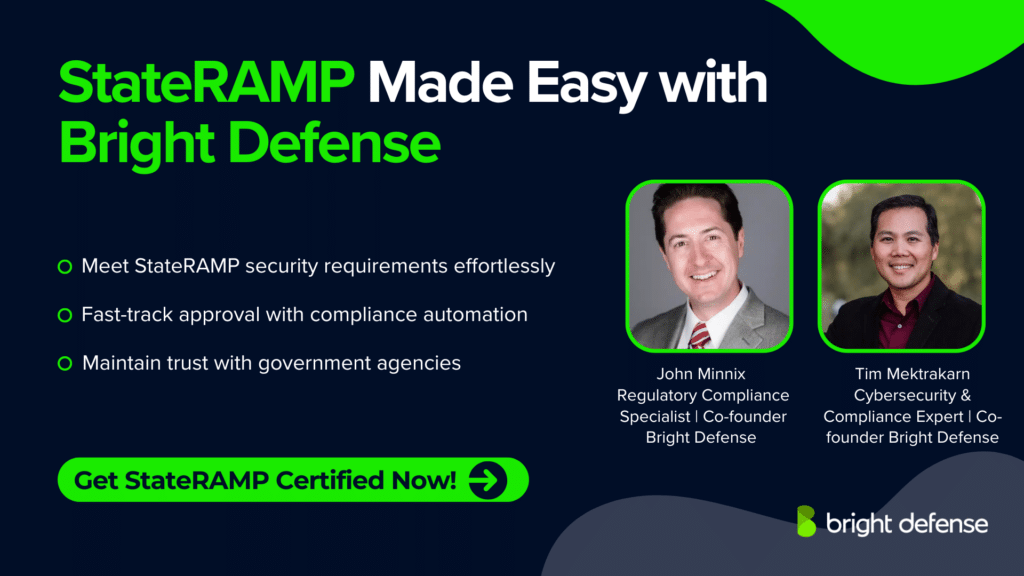
StateRAMP vs. FedRAMP: Key Differences and Similarities
Here’s a detailed comparison to help you discern which framework might be more appropriate for your business needs:
Common Ground
- Standards-Based Security Controls: Both StateRAMP and FedRAMP are built on NIST standards, specifically leveraging NIST SP 800-53 for establishing security controls, ensuring high protection and consistency.
- Risk Management Focus: Each framework emphasizes risk management and continuous monitoring to maintain an ongoing assessment of cloud services to mitigate potential vulnerabilities.
- Third-Party Assessment: Both require cloud service providers (CSPs) to undergo third-party assessments to validate compliance, ensuring an independent verification of security measures.
Key Differences
- Scope of Application:
- FedRAMP: FedRAMP mandates all cloud services used by the federal government and maintains a nationwide focus for federal agencies.
- StateRAMP: It targets state and local government agencies, providing a rigorous security assessment tailored to state-level operations.
- Compliance and Oversight:
- FedRAMP: Managed by the General Services Administration (GSA), it has a centralized approach to oversight, which can be stringent and highly structured.
- StateRAMP: While it follows a model similar to FedRAMP, oversight can vary significantly depending on the state. This can mean more flexibility or additional requirements specific to local laws and regulations.
- Cost and Time:
- FedRAMP: Often seen as more costly and time-consuming due to its comprehensive and rigorous assessment processes.
- StateRAMP: May offer a more cost-effective and faster pathway to compliance for businesses primarily serving state and local governments.
Whether to pursue FedRAMP or StateRAMP certification should align with your business strategy, target market, and resource availability.

Impact on Businesses
Understanding and navigating the complexities of StateRAMP and FedRAMP can be a pivotal factor in securing and successfully executing government contracts. Here’s how these frameworks could impact your business:
- Access to Government Contracts: Compliance with FedRAMP or StateRAMP is often a prerequisite for bidding on government contracts that involve cloud services. Certification opens doors to new business opportunities within federal or state and local government sectors, respectively.
- Credibility and Competitive Advantage: Certification demonstrates to potential government clients that your business takes cybersecurity seriously and meets rigorous standards. This can differentiate your business from competitors who are not certified, giving you a competitive edge.
- Resource Allocation: Becoming compliant with these frameworks can be resource-intensive. Small businesses must consider the costs of achieving and maintaining compliance, which include the expenses related to security enhancements, the auditing process, and ongoing monitoring.
- Long-term Strategic Planning: Pursuing FedRAMP or StateRAMP certification should align with your business’s long-term strategic goals. For instance, if your primary target market is local government agencies, StateRAMP might be more relevant and cost-effective for your needs.
- Partnerships and Collaborations: Small businesses might find it advantageous to partner with other companies already FedRAMP or StateRAMP certified. This can help in sharing the burden of compliance costs and leveraging existing certified platforms to deliver secure services.
Navigating the requirements of StateRAMP and FedRAMP can be daunting, especially for small businesses with limited resources. However, the investment in compliance not only facilitates access to lucrative government contracts but also enhances the overall security posture of the business, protecting it against cyber threats and breaches. Thus, while the initial costs might be significant, the long-term benefits of compliance—securing government contracts and establishing trust—can provide substantial returns on investment.
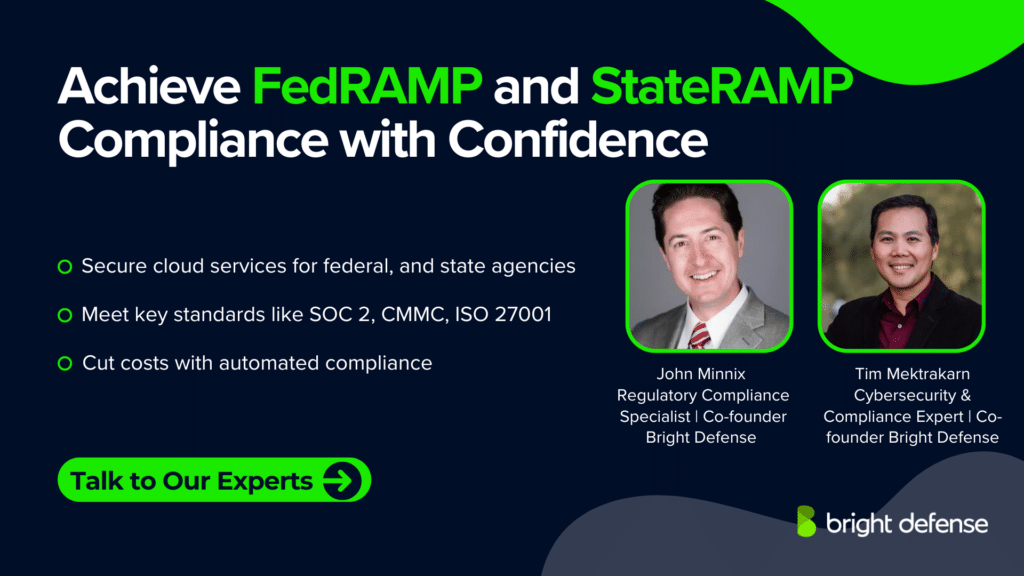
Strategic Considerations of StateRAMP vs. FedRAMP
When deciding whether to pursue FedRAMP or StateRAMP certification, small businesses must weigh several strategic considerations to ensure alignment with their long-term goals and capabilities. Here are key factors to consider:
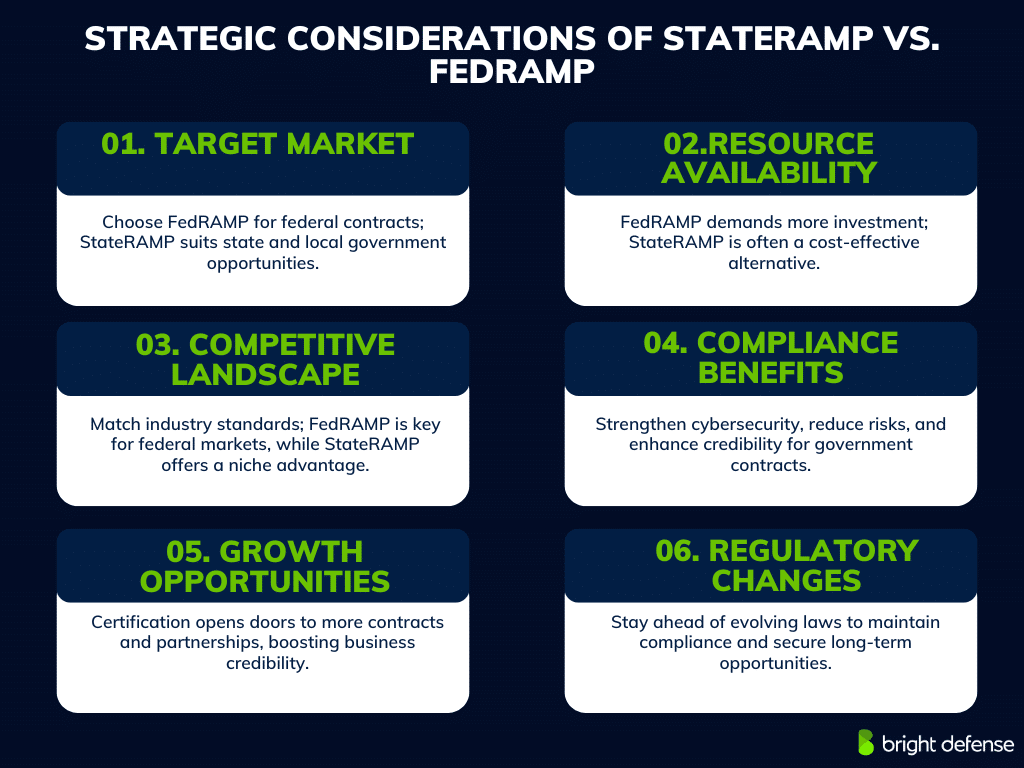
1. Target Market
Determine whether federal agencies or state and local governments are more likely to need your services. FedRAMP is essential for federal contracts, while StateRAMP opens doors to state and local government opportunities. Understanding where your potential clients operate will guide which certification is more relevant.
2. Resource Availability
Assess your business’s ability to allocate resources, including time, money, and personnel, to achieving and maintaining compliance. FedRAMP generally requires a more significant investment due to its comprehensive nature, whereas StateRAMP might be a more feasible option for businesses with tighter budgets.
3. Competitive Landscape
Analyze the competitive environment within your industry. If many competitors are FedRAMP certified, obtaining FedRAMP certification might be necessary to stay competitive in federal markets. Conversely, StateRAMP could be a strategic move to differentiate your business in state and local markets.
4. Compliance Benefits
Beyond meeting requirements for government contracts, consider the broader benefits of compliance. Both certifications enhance your cybersecurity posture, making your business more secure and potentially reducing insurance costs or mitigating risks of data breaches.
5. Growth Opportunities
Look at certification as an investment in your business’s growth. Being certified can help you secure contracts and build a reputation as a trusted service provider, leading to more business opportunities and partnerships.
6. Regulatory Changes
Keep an eye on evolving regulations both at federal and state levels. New laws and standards can affect the relevance of FedRAMP and StateRAMP, and staying proactive in compliance can offer strategic advantages.
Ultimately, the decision to pursue FedRAMP or StateRAMP certification should be made with a clear understanding of your business strategy, market needs, and the regulatory landscape. This strategic alignment will help ensure that your efforts and resources in achieving certification yield optimal returns and foster sustainable business growth.

Are the security standards for StateRAMP and FedRAMP the same?
While both StateRAMP and FedRAMP are grounded in the National Institute of Standards and Technology’s (NIST) Special Publication 800-53 framework, their application and governance differ to cater to their respective jurisdictions.
1. Shared Foundation
Both programs utilize the NIST SP 800-53 controls as a baseline, ensuring a comprehensive approach to security. This alignment guarantees that cloud service providers (CSPs) adhere to a standardized set of controls, promoting consistency across federal, state, and local governments.
2. Distinct Governance and Application
FedRAMP is a federally mandated program managed by the General Services Administration (GSA), focusing on cloud services for federal agencies. It requires CSPs to obtain an Authority to Operate (ATO) from a federal agency or a Provisional ATO from the Joint Authorization Board (JAB).
In contrast, StateRAMP is a nonprofit organization that collaborates with state and local governments to standardize cloud security. While it mirrors FedRAMP’s structure, StateRAMP offers more flexibility, allowing states to tailor requirements to their specific needs. This adaptability ensures that CSPs can meet diverse security expectations across various jurisdictions.
3. Continuous Monitoring and Visibility
Both programs emphasize continuous monitoring to maintain security compliance. However, their approaches to visibility differ. StateRAMP provides state and local governments with access to a secure repository, enabling consistent oversight of their vendors’ security postures. In contrast, FedRAMP documentation is accessible only to the federal agencies that work with the providers
Final Thoughts
Achieving StateRAMP and FedRAMP certification is a pivotal step for small businesses that aim to expand their reach within government contracting. These frameworks serve as benchmarks for cybersecurity excellence and as essential credentials that open doors to lucrative government projects. By aligning your compliance strategy with your business goals and leveraging the insights from these frameworks, your company can demonstrate its commitment to security and gain a strategic edge.
Remember, while demanding, the journey towards certification equips your business with the robust security infrastructure necessary to compete effectively in the high-stakes arena of government contracts. With careful planning and the right support, the path to compliance can lead to significant business growth and long-term success.
Bright Defense Delivers FedRAMP and StateRAMP Compliance Solutions!
If you are planning to begin the StateRAMP or FedRAMP authorization process, Bright Defense can help. Our monthly engagement model helps you achieve and maintain compliance with frameworks including StateRAMP, FedRAMP, SOC 2, CMMC, ISO 27001, and more. We combine our vCSIO services with compliance automation software to decrease costs and increase efficiency. Once the security requirements are met to meet your desired framework, After achieving compliance, we maintain your security program to ensure you are up to date with the evolving regulatory and threat landscape.
Contact Bright Defense today to get started!
If you enjoyed this article, we think you’ll like “FedRAMP vs. CMMC Compliance“.
FAQs on StateRAMP vs. FedRAMP
StateRAMP focuses on cloud security compliance for state and local governments, while FedRAMP is a federal program ensuring cybersecurity standards for cloud services used by federal agencies. Both follow similar security principles, but their governance and areas of enforcement differ.
FedRAMP compliance is required for any cloud provider working with federal agencies. StateRAMP is not universally mandated but is being widely adopted by state and local governments, meaning service providers looking to work with these entities may need to comply.
FedRAMP requires cloud providers to obtain an Authority to Operate (ATO) from a federal agency or a Provisional ATO from the Joint Authorization Board (JAB). StateRAMP, on the other hand, offers a more streamlined approval process, allowing cloud providers to demonstrate security compliance in a way that facilitates faster access to state and local government contracts.
Although FedRAMP authorization confirms that a provider meets stringent federal security requirements, state and local governments often have additional compliance measures. StateRAMP helps standardize these requirements across multiple states, reducing the need for repeated security assessments.
StateRAMP certification simplifies the process of working with multiple state and local governments by providing a centralized security approval. It also increases trust, reduces the need for individual state security assessments, and enhances opportunities for public sector contracts.
Yes, StateRAMP offers an expedited process for providers who already have FedRAMP authorization, allowing them to transition more quickly into state and local government markets without undergoing a full security review from scratch.
85% of stakeholders agree that FedRAMP plays a key role in enabling secure cloud adoption across federal agencies. It provides a centralized approach to security, reducing duplication of efforts and making it easier for agencies to adopt vetted cloud solutions.
To address concerns from cloud providers and agencies, FedRAMP is:
– Updating documentation for clearer guidance on security baselines
– Enhancing communication about upcoming policy changes
– Automating parts of the authorization process to shorten approval times
– Providing practical guidance to help providers navigate the compliance process
– Clarifying roles and responsibilities to ensure smoother implementation
Get In Touch


